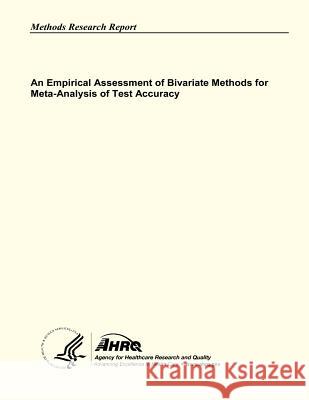An Empirical Assessment of Bivariate Methods for Meta-Analysis of Test Accuracy » książka
An Empirical Assessment of Bivariate Methods for Meta-Analysis of Test Accuracy
ISBN-13: 9781483925448 / Angielski / Miękka / 2013 / 100 str.
Medical tests are used every day for guiding diagnosis, predicting the future course of disease, and guiding treatment selection. The effects of tests on clinical outcomes are indirect, through their influence on physicians' diagnostic thinking and treatment decisionmaking. Comparative studies of testing versus no testing that can answer the overarching question of test effectiveness (clinical utility) are rarely performed. Because of this, assessment of medical tests often relies only on the evaluation of test accuracy, or test performance, typically measured by sensitivity and specificity (clinical validity of tests). Even when studies of clinical utility are available, systematic reviews of test performance are an important component of any comprehensive evidence assessment of a medical test. In most cases tests are used to classify patients into two mutually exclusive and exhaustive groups (test positive and test negative)-positive test results indicate that patients are more likely to have the condition of interest and should be targeted for additional diagnostic investigation or considered for therapeutic intervention. In such cases, test accuracy can be expressed as the ability to identify individuals with disease as test positives (sensitivity) and individuals with no disease as test negatives (specificity). Additional accuracy metrics, such as the area under the receiver operating characteristic (ROC) curve, the diagnostic odds ratio, or the Q* statistic (the point on the ROC curve where sensitivity equals specificity), are often reported in primary studies. Individual studies of test accuracy tend to be small and are often conducted in diverse settings. Systematic reviews of medical test studies offer a natural framework for evidence synthesis. When the aim is to increase precision or quantitatively assess the impact of study-level characteristics on test sensitivity or specificity, meta-analytic methods can be used to combine the results of independent studies into summary estimates of accuracy or to identify modifiers of accuracy through meta-regression. Meta-analysis of studies of test accuracy presents several challenges to systematic reviewers. First, meta-analysis of sensitivity and specificity requires modeling a multivariate outcome (sensitivity and specificity reported from each study). Second, joint modeling of sensitivity and specificity needs to take into account the correlation of these estimates across studies induced by threshold effects. Third, studies often produce heterogeneous results, necessitating the use of random effects models when the interest is to generalize beyond the observed data. Analyses that fail to take into account threshold effects or between-study variability may produce incompatible estimates of sensitivity and specificity or spuriously precise estimates of test accuracy. This report is the second in a series of three on meta-analysis of test accuracy, conducted by the Tufts Evidence-based Practice Center under contract with the Agency for Healthcare Research and Quality (AHRQ). For the current project we sought to perform a large-scale empirical comparison of alternative meta-analysis methods for sensitivity and specificity and for constructing SROC curves. This report addresses the following aims by using a previously established database of meta-analytic datasets: Compare univariate (one outcome at a time) and bivariate (joint analysis of two outcomes) methods for meta-analysis of sensitivity and specificity; Compare inverse variance (DerSimonian-Laird), maximum likelihood (ML) and Bayesian methods for random effects meta-analysis of sensitivity and specificity; Compare methods using a normal approximation versus those using the exact binomial likelihood for meta-analysis of sensitivity and specificity; Compare alternative statistical models for constructing meta-analytic SROC curves.
Zawartość książki może nie spełniać oczekiwań – reklamacje nie obejmują treści, która mogła nie być redakcyjnie ani merytorycznie opracowana.











